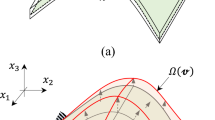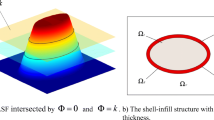Abstract
A new topology optimization using adaptive inner-front level set method is presented. In the conventional level set-based topology optimization, the optimum topology strongly depends on the initial level set due to the incapability of inner-front creation during the optimization process. In the present work, in this regard, an algorithm for inner-front creation is proposed in which the sizes, the positions, and the number of new inner-fronts during the optimization process can be globally and consistently identified. In the algorithm, the criterion of inner-front creation for compliance minimization problems of linear elastic structures is chosen as the strain energy density along with volumetric constraint. To facilitate the inner-front creation process, the inner-front creation map is constructed and used to define new level set function. In the implementation of inner-front creation algorithm, to suppress the numerical oscillation of solutions due to the sharp edges in the level set function, domain regularization is carried out by solving the edge smoothing partial differential equation (smoothing PDE). To update the level set function during the optimization process, the least-squares finite element method (LSFEM) is adopted. Through the LSFEM, a symmetric positive definite system matrix is constructed, and non-diffused and non-oscillatory solution for the hyperbolic PDE such as level set equation can be obtained. As applications, three-dimensional topology optimization of shell structures is treated. From the numerical examples, it is shown that the present method brings in much needed flexibility in topologies during the level set-based topology optimization process.
Similar content being viewed by others
References
Allaire G, Jouve F, Toader AM (2004) Structural optimization using sensitivity analysis and a level set method. J Comput Phys 194:363–393
Allaire G, Jouve F, Toader AM (2005) Structural optimization using topological and shape sensitivity via a level set method. Control Cyber 34:59–80
Amstutz V, Andra H (2006) A new algorithm for topology optimization using a level-set method. J Comput Phys 216:573–588
Aubert G, Kornprobst P (2001) Mathematical problems in image processing: partial differential equations and the calculus of variations. Springer, Berlin
Belblidia F, Bulman S (2002) A hybrid topology optimization algorithm for static and vibrating shell structures. Int J Numer Methods Eng 54:835–852
Bendsøe MP, Kikuchi N (1988) Generating optimal topologies in structural design using a homogenization method. Comput Methods Appl Mech Eng 71:197–224
Bendsøe MP, Sigmund O (2003) Topology optimization—theory, methods and applications. Springer-Verlag, Berlin
Burger M, Hackl B, Ring W (2004) Incorporating topological derivatives into level set methods. J Comput Phys 194:344–362
Céa J, Garreau S, Guillaume P, Masmoudi M (2000) The shape and topological optimizations connection. Comput Methods Appl Mech Eng 188:713–726
Ha SH, Cho SH (2005) Topological shape optimization of heat conduction problems using level set approach. Numer Heat Trans Part B 48:67–88
Haftka RT, Gürdal Z (1992) Elements of structural optimization. Kluwer, Dordrechet
Harber RB, Jog CS, Bendsøe MP (1996) A new approach to variable—topology shape design using a constraint on perimeter. Struct Optim 11:1–12
Haug EJ, Choi KK, Komkov V (1986) Design sensitivity analysis of structural systems. Academic, Orlando
Jiang BN (1998) The least-squares finite element method. Springer, Berlin
Kwak JH, Cho SH (2005) Topological shape optimization of geometrically nonlinear structures using level set method. Comput Struct 83:2257–2268
Lee S, Soni BK (1997) Governing equation of fluid mechanics in physical curvilinear coordinate system. In: Proceedings of the 3rd Mississippi state conference on difference equations and computational simulations. Mississippi State, USA, pp 149–157
Lee SJ, Bae JE, Hinton E (2000) Shell topology optimization using the layered artificial material model. Int J Numer Methods Eng 47:843–867
Li Q, Steven GP, Querin OM (1999) Optimization of thin shell structures subjected to thermal loading. Struct Eng Mech 7:401–412
Maute K, Ramm E (1996) Adpative topology optimization of shell structures. In: Proceedings of the 6th AIAA/NASA/ISSMO symposium on multidisciplinary analysis and optimization. Bellevue, USA, pp 1133–1141
Mei Y, Wang XM (2004) Level set method for structural topology optimization and its applications. Adv Eng Softw 35:415–441
Novotny AA, Feijoo RA, Taroco E, Padra C (2003) Topological sensitivity analysis. Comput Methods Appl Mech Eng 192:803–829
Oden JT, Demkowicz LF (1996) Applied functional analysis. CRC Press, Florida
Osher S, Fedkiw R (2003) Level set methods and dynamic implicit surfaces. Springer, Berlin
Osher S, Sethian JA (1998) Fronts propagating with curvature dependent speed: algorithms based on Hamilton–Jacobi formulations. J Comput Phys 79:12–49
Rosen JB (1960) The gradient projection method for nonlinear programming, part I, linear constraints. J Soc Industrial Appl Math 8:181–217
Sethian JA (1999) Level set methods and fast marching methods: evolution interfaces in computational geometry, fluid mechanics, computer vision, and meterail science. Cambridge Univ. Press, Cambridge
Sethian JA, Wiegmann (2000) A structural boundary design via level se and immersed interface method. J Comput Phys 163:489–528
Simon J (1980) Differentiation with respect to the domain in boundary value problems. Numer Function Anal Optim 2:649–687
Sokołowski J, Żochowski A (1999) On the topological derivative in shape optimization. SIAM J Control Optim 37:1251–1272
Takahira H, Horiuchi T, Banerjee S (2004) An improved three-dimensional level set method for gas–liquid two-phase flows. J Fluids Eng 126:578–585
Tenek LH, Hagiwara I (1994) Optimal rectangular plate and shallow shell topologies using thickness distribution or homogenization. Comput Methods Appl Mech Eng 115:111–124
Wang MY, Wang XM (2004) Color level sets: a multi-phase level set method for structural topology optimization with multiple materials. Comput Methods Appl Mech Eng 193:469–496
Wang MY, Wang XM, Guo DM (2003) A level set method for structural topology optimization. Comput Methods Appl Mech Eng 192:227–246
Youn SK, Park SH (1997) A study on the shape extraction process in the structural topolgy optimization using homogenized material. Comput Struct 62:527–538
Yue W, Lin CL, Patel VC (2005) Coherent structures in open-channel flows over a fixed dune. J Fluids Eng 127:858–864
Author information
Authors and Affiliations
Corresponding author
Rights and permissions
About this article
Cite this article
Park, KS., Youn, SK. Topology optimization of shell structures using adaptive inner-front (AIF) level set method. Struct Multidisc Optim 36, 43–58 (2008). https://doi.org/10.1007/s00158-007-0169-4
Received:
Revised:
Accepted:
Published:
Issue Date:
DOI: https://doi.org/10.1007/s00158-007-0169-4




